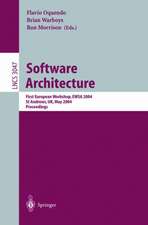MOSFET Models for VLSI Circuit Simulation: Theory and Practice: Computational Microelectronics
Autor Narain D. Aroraen Limba Engleză Paperback – 22 ian 2012
Din seria Computational Microelectronics
- 18%
 Preț: 944.51 lei
Preț: 944.51 lei - 20%
 Preț: 438.50 lei
Preț: 438.50 lei - 18%
 Preț: 954.45 lei
Preț: 954.45 lei - 15%
 Preț: 646.11 lei
Preț: 646.11 lei - 18%
 Preț: 951.91 lei
Preț: 951.91 lei - 18%
 Preț: 952.09 lei
Preț: 952.09 lei - 15%
 Preț: 638.11 lei
Preț: 638.11 lei - 15%
 Preț: 642.51 lei
Preț: 642.51 lei - 18%
 Preț: 954.45 lei
Preț: 954.45 lei -
 Preț: 390.08 lei
Preț: 390.08 lei -
 Preț: 386.99 lei
Preț: 386.99 lei -
 Preț: 397.38 lei
Preț: 397.38 lei -
 Preț: 392.97 lei
Preț: 392.97 lei - 24%
 Preț: 742.68 lei
Preț: 742.68 lei - 18%
 Preț: 1842.31 lei
Preț: 1842.31 lei - 15%
 Preț: 584.25 lei
Preț: 584.25 lei
Preț: 666.40 lei
Preț vechi: 833.01 lei
-20% Nou
Puncte Express: 1000
Preț estimativ în valută:
127.52€ • 133.47$ • 106.13£
127.52€ • 133.47$ • 106.13£
Carte tipărită la comandă
Livrare economică 31 martie-14 aprilie
Preluare comenzi: 021 569.72.76
Specificații
ISBN-13: 9783709192498
ISBN-10: 3709192498
Pagini: 632
Ilustrații: XXII, 605 p.
Dimensiuni: 170 x 244 x 33 mm
Greutate: 0.99 kg
Ediția:Softcover reprint of the original 1st ed. 1993
Editura: SPRINGER VIENNA
Colecția Springer
Seria Computational Microelectronics
Locul publicării:Vienna, Austria
ISBN-10: 3709192498
Pagini: 632
Ilustrații: XXII, 605 p.
Dimensiuni: 170 x 244 x 33 mm
Greutate: 0.99 kg
Ediția:Softcover reprint of the original 1st ed. 1993
Editura: SPRINGER VIENNA
Colecția Springer
Seria Computational Microelectronics
Locul publicării:Vienna, Austria
Public țintă
ResearchCuprins
1 Overview.- 1.1 Circuit Design with MOSFETs.- 1.2 MOSFET Modeling.- 1.3 Model Parameter Determination.- 1.4 Interconnect Modeling.- 1.5 Subjects Covered.- References.- 2 Review of Basic Semiconductor and pn Junction Theory.- 2.1 Energy Band Model.- 2.2 Intrinsic Semiconductor.- 2.3 Extrinsic or Doped Semiconductor.- 2.4 Electrical Conduction.- 2.5 pn Junction at Equilibrium.- 2.6 Diode Current-Voltage Characteristics.- 2.7 Diode Dynamic Behavior.- 2.8 Real pn Junction.- 2.9 Diode Circuit Model.- 2.10 Temperature Dependent Diode Model Parameters.- References.- 3 MOS Transistor Structure and Operation.- 3.1 MOSFET Structure.- 3.2 MOSFET Characteristics.- 3.3 MOSFET Scaling.- 3.4 Hot-Carrier Effects.- 3.5 VLSI Device Structures.- 3.6 MOSFET Parasitic Elements.- 3.7 MOSFET Length and Width Definitions.- 3.8 MOSFET Circuit Models.- References.- 4 MOS Capacitor.- 4.1 MOS Capacitor with No Applied Voltage.- 4.2 MOS Capacitor at Non-Zero Bias.- 4.3 Capacitance of MOS Structures.- 4.4 Deviation from Ideal C-V Curves.- 4.5 Anomalous C-V Curve (Polysilicon Depletion Effect).- 4.6 MOS Capacitor Applications.- 4.7 Nonuniformly Doped Substrate and Flat Band Voltage.- References.- 5 Threshold Voltage.- 5.1 MOSFET with Uniformly Doped Substrate.- 5.2 Nonuniformly Doped MOSFET.- 5.3 Threshold Voltage Variations with Device Length andWidth.- 5.4 Temperature Dependence of the Threshold voltage.- References.- 6 MOSFET DC Model.- 6.1 Drain Current Calculations.- 6.2 Pao-Sah Model.- 6.3 Charge-Sheet Model.- 6.4 Piece-Wise Drain Current Model for EnhancementDevices.- 6.5 Drain Current Model for Depletion Devices.- 6.6 Effective Mobility.- 6.7 Short-Geometry Models.- 6.8 Impact of Source-Drain Resistance on Drain Current.- 6.9 Temperature Dependence of the Drain Current.- References.- 7 Dynamic Model.- 7.1 Intrinsic Charges and Capacitances.- 7.2 Charge-Based Capacitance Model.- 7.3 Long-Channel Charge Model.- 7.4 Short-Channel Charge Model.- 7.5 Limitations of the Quasi-Static Model.- 7.6 Small-Signal Model Parameters.- References.- 8 Modeling Hot-Carrier Effects.- 8.1 Substrate Current Model.- 8.2 Gate Current Model.- 8.3 Correlation of Gate and Substrate Current.- 8.4 Mechanism of MOSFET Degradation.- 8.5 Measure of Degradation—Device Lifetime.- 8.6 Impact of Degradation on Circuit Performance.- 8.7 Temperature Dependence of Device Degradation.- References.- 9 Data Acquisition and Model Parameter Measurements.- 9.1 Data Acquisition.- 9.2 Gate-Oxide Capacitance Measurement.- 9.3 Measurement of Doping Profile in Silicon.- 9.4 Measurement of Threshold Voltage.- 9.5 Determination of Body Factor ?.- 9.6 Flat Band Voltage.- 9.7 Drain Induced Barrier Lowering (DIBL) Parameter.- 9.8 Determination of Subthreshold Slope.- 9.9 Carrier Inversion Layer Mobility Measurement.- 9.10 Determination of Effective Channel Length and Width.- 9.11 Determination of Drain Saturation Voltage.- 9.12 Measurement of MOSFET Intrinsic Capacitances.- 9.13 Measurement of Gate Overlap Capacitance.- 9.14 Measurement of MOSFET Source/Drain Diode JunctionParameters.- References.- 10 Model Parameter Extraction Using Optimization Method.- 10.1 Model Parameter Extraction.- 10.2 Basics Definitions in Optimization.- 10.3 Optimization Methods.- 10.4 Some Remarks on Parameter Extraction Using OptimizationTechnique.- 10.5 Confidence Limits on Estimated Model Parameter.- 10.6 Parameter Extraction Using Optimizer.- References.- 11 SPICE Diode and MOSFET Models and Their Parameters.- 11.1 Diode Model.- 11.2 MOSFET Level 1 Model.- 11.3 MOSFET Level 2 Model.- 11.4 MOSFET Level 3 Model.- 11.5 MOSFETLevel 4 Model.- 11.6 Comparison of the Four MOSFET Models.- References.- 12 Statistical Modeling and Worst-Case Design Parameters.- 12.1 Methods of Generating Worst Case Parameters.- 12.2 Model Parameter Sensitivity.- 12.3 Statistical Analysis with Parameter Correlation.- 12.4 Factor Analysis.- 12.5 Optimization Method.- References.- Appendix A. Important Properties of Silicon, Silicon Dioxide and Silicon Nitride at 300 K.- Appendix B. Some Important Physical Constants at 300 K.- Appendix C. Unit Conversion Factors.- Appendix D. Magnitude Prefixes.- Appendix F. Charge Based MOSFET Intrinsic Capacitances.- Appendix G. Linear Regression.- Appendix H. Basic Statistical and Probability Theory.- Appendix I. List of Widely Used Statistical Package Programs.




















